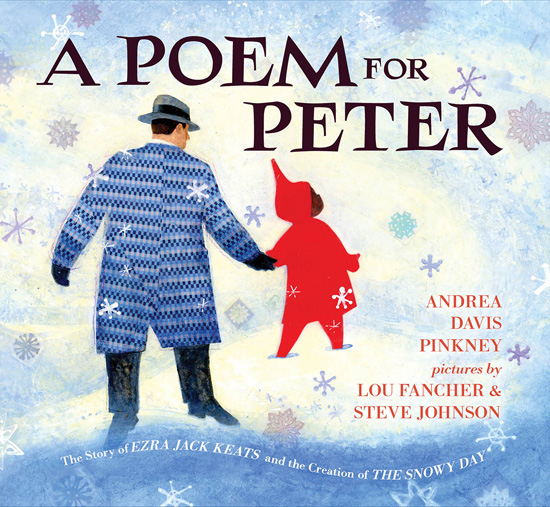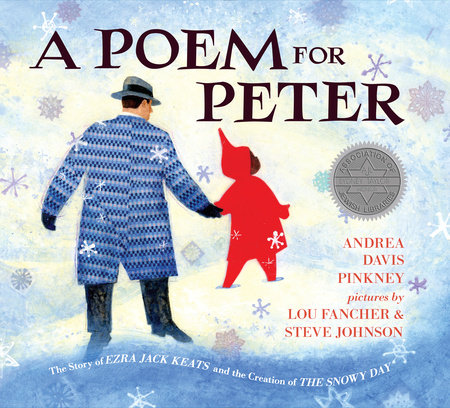Illustrators Lou Fancher and
Steve Johnson on Giving
A Poem for Peter Its Visual Depth
by the Brightly Editors
Lou Fancher and Steve Johnson are the illustrators behind Brightly’s Book Club for Kids pick A Poem for Peter, a captivating picture book biography of the boundary-breaking author Ezra Jack Keats. We were thrilled to ask the artistic duo (and real-life married couple!) about how they reacted when they found out they’d be working on A Poem for Peter, why collage is so exciting to create, and what even the most experienced artists can learn from children.
Click here to learn more about Brightly’s Book Club for Kids, discover A Poem for Peter-inspired activities and tips for discussion, and join in on the reading fun.
How familiar were you with Ezra Jack Keats before you started working on A Poem for Peter? What were some of your thoughts when you found out you’d be part of this project?
We were very familiar with his books, but less familiar with his biographical history. Because we are big researchers, we spent hours learning everything we could about his background, the time in which he worked, other artists in multiple genres making work at that time, and the story behind the little boy who inspired Peter. We also read and researched a lot about contemporary issues having to do with why so few people of color are featured in children’s books. And we dug into Andrea Davis Pinkney’s history and work. Our thoughts when we found out we’d be part of the project were more instantaneous: Super! Yippee! Thank you Denise Cronin (art director) and Regina Hayes (editor) for believing in us!
Illustration is typically very hands-on — how do you collaborate on projects, working together as an artistic duo?
It varies from book to book. Basically, we do solo thinking and doodling, then meet “in the field” and start to hash out our visions and where they intersect. Then we figure out who does what according to who is best at doing what’s needed or who has the time! We fight sometimes too, just so you know it’s not all rosy. Usually, you win some battles, you lose others. Hopefully, in the end, the book is the best we can produce together.

How did you go about blending elements of Keats’s work with this brand-new story? What were some of the challenges, and fun, of merging his illustration style with your styles?
It was natural, in many ways. We had been doing collage for years and, with the collage, incorporating almost a second illustrated story within paintings. Adding elements of Keats’s style to parallel, but never copy, his “look” led us to simplify the collage, but did not require changing the approach because it was already aligned. Collage is texture. Color and form are the frames that contain texture and give it dimension.
The biggest challenges we had were trying not to be intimidated by his masterful use of the technique. The most fun moments were when a painting was done!

In A Poem for Peter, Keats’s biography is layered into a new visual narrative. What elements of the story did you really want to amplify in the artwork? How did the style of the artwork you created aid in telling the story?
We wanted to pay homage to Peter. We hoped to mirror and shine a light on Andrea’s terrific storytelling. We aimed to provide readers with the punch of a big picture and the pleasure of tiny details to study and wonder about, and maybe even use that wonder to make up their own stories.

Can you talk about the process of conceptualizing and creating the illustration on the cover of the book, featuring the two figures holding hands?
It started with the text, as it always does, but also, with the idea of their feet not touching the ground. Weightlessness made them not angels, but magical. The held hands are their obvious connection and a universal symbol of love; the snow swirling around puts them in a private world. There was also an image our art director liked that had figures in a central circle that isolated but also emphasized their importance — that idea was influential in our choice to dial in on just the two characters.

Some readers might like to know this insider tidbit: The pattern on Keats’s jacket is actually from a tie Lou’s dad sent to her. She photographed it, then manipulated the colors that were all brown hues to blue tones. Keats is “wearing” her dad’s old tie!
Also, Lou cut a TON of snowflakes and learned that one wrong snip with scissors can spell disaster!
Some kids might be inspired to create their own illustrated biographies or autobiographies. Do you have any advice for young readers who want to create collages that reflect the personal stories they want to tell?
Honestly, we think kids should give us advice. They are naturally creative, visually courageous, and instinctively inclusive. If they trust themselves, they could make a list of their favorite things to start. Then, they just need to remember that almost anything can be used — rocks, old letters, stamp collections, food packages, magazines, favorite books, fabric, photographs and more. If they’re working on a biography, well, kids are great at pretending. They can just imagine themselves as the person whose story they want to tell and apply the same guidelines.
What are you two working on next?
We have two books we are just about to start working on, and we are always hoping for more! That means we are working on letting people know how much we love to design and illustrate books for kids.
-
A Poem for Peter: The Story of Ezra Jack Keats and the Creation of The Snowy Day
Available from:Also available from:
Lou Fancher and Steve Johnson have worked as a creative team for over 26 years, producing illustrations for annual reports, brochures, posters, movies, advertisements, book covers and magazines. Together they have illustrated over 50 children’s books, including Dr. Seuss’s My Many Colored Days, Garrison Keillor’s Cat, You Better Come Home, and Jon Scieszka’s The Frog Prince, Continued. Their 2000 release, I Walk At Night, was recognized as one of The New York Times Best Illustrated Books. They are the recipients of a gold medal from the Society of Illustrators and have been recognized by Communication Arts, Print, and Graphis. Lou and Steve provided set and character development for Pixar’s “Toy Story” and “A Bug’s Life.” They live in Moraga, California. Visit their website at JohnsonandFancher.com

